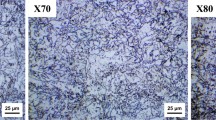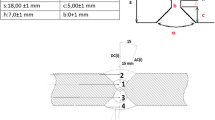In the current research, we investigate fatigue crack growth in an API X65 pipeline steel by using an Instron fatigue testing machine. To this, first the microstructure of steel was accurately investigated using scanning electron microscope. Since nonmetallic inclusions play a key role during crack propagation, the type and distribution of such inclusions were studied through the thickness of as-received X65 steel using energy-dispersive spectroscopy technique. It was found that the accumulation of such defects at the center of thickness of the pipe body was higher than in other regions. Our results showed that there were very fine oxide inclusions (1-2 µm in length) appeared throughout the cross section of X65 steel. Such inclusions were observed not at the fatigue crack path nor on both sides of the fatigue crack. However, we found that large manganese sulfide inclusions (around 20 µm in length) were associated with fatigue crack propagation. Fatigue experiments on CT specimens showed that the crack nucleated when the number of fatigue cycles was higher than 340 × 103. On fracture surfaces, crack propagation also occurred by joining the microcracks at tip of the main crack.












Similar content being viewed by others
References
E. Gamboa, V. Linton, and M. Law, Fatigue of Stress Corrosion Cracks in X65 Pipeline Steels, Int. J. Fatigue, 2008, 30, p 850–860
R.L. Amaro, N. Rustagi, K.O. Findley, E.S. Drexler, and A.J. Slifka, Modeling the Fatigue Crack Growth of X100 Pipeline Steel in Gaseous Hydrogen, Int. J. Fatigue, 2014, 59, p 262–271
M.A. Arafin and J.A. Szpunar, Effect of Bainitic Microstructure on the Susceptibility of Pipeline Steels to Hydrogen Induced Cracking, Mater. Sci. Eng., A, 2011, 528, p 4927–4940
M.A. Arafin and J.A. Szpunar, A New Understanding of Intergranular Stress Corrosion Cracking Resistance of Pipeline Steel Through Grain Boundary Character and Crystallographic Texture Studies, Corros. Sci., 2009, 51, p 119–128
M.A. Mohtadi-Bonab, R. Karimdadashi, M. Eskandari, and J.A. Szpunar, Hydrogen-Induced Cracking Assessment in Pipeline Steels Through Permeation and Crystallographic Texture Measurements, J. Mater. Eng. Perform., 2016, 25, p 1781–1793
V.M. Pleskach and P.A. Averchenko, Effect of Gaseous Erosion on a Decrease of the Fatigue Strength of Specimens of Titanium Alloy VT8, Strength Mater., 1975, 7, p 1036–1037
V. Olden, A. Alvaro, and O.M. Akselsen, Hydrogen Diffusion and Hydrogen Influenced Critical Stress Intensity in an API, X70 Pipeline Steel Welded Joint – Experiments and FE simulations, Int. J. Hydrogen Energy, 2012, 37, p 11474–11486
H.J. Christ, A. Jung, H.J. Maier, and R. Teteruk, Thermomechanical Fatigue-Damage Mechanisms and Mechanism-Based Life Prediction Methods, Sadhana, 2003, 28, p 147–165
S. Hassanifard, M.A. Mohtadi-Bonab, and Gh Jabbari, Investigation of Fatigue Crack Propagation in Spot-Welded Joints Based on Fracture Mechanics Approach, J. Mater. Eng. Perform., 2013, 22, p 245–250
J.F. Cooper and R.A. Smith, The Measurement of Fatigue Cracks at Spot-Welds, Int. J. Fatigue, 1985, 7, p 137–140
J.W. Sowards, T. Gnäupel-Herold, J.D. McColskey, V.F. Pereira, and A.J. Ramirez, Characterization of Mechanical Properties, Fatigue-Crack Propagation, and Residual Stresses in a Microalloyed Pipeline-Steel Friction-Stir Weld, Mater. Des., 2015, 88, p 632–642
J.A. Ronevich, B.P. Somerday, and C.W.S. Marchi, Effects of Microstructure Banding on Hydrogen Assisted Fatigue Crack Growth in X65 Pipeline Steels, Int. J. Fatigue, 2016, 82, p 497–504
M. Yu, W. Chen, R. Kania, G. Boven, and J. Been, Crack Propagation of Pipeline Steel Exposed to a Near-Neutral pH Environment Under Variable Pressure Fluctuations, Int. J. Fatigue, 2016, 82, p 658–666
B.T. Lu, Further Study on Crack Growth Model of Buried Pipelines Exposed to Concentrated Carbonate-Bicarbonate Solution, Eng. Fract. Mech., 2014, 131, p 296–314
F. Huang, J. Liu, Z.J. Deng, J.H. Cheng, Z.H. Lu, and X.G. Li, Effect of Microstructure and Inclusions on Hydrogen Induced Cracking Susceptibility and Hydrogen Trapping Efficiency of X120 pipeline steel, Mater. Sci. Eng., A, 2010, 527, p 6997–7001
J. Moon, C. Park, and S.J. Kim, Influence of Ti Addition on the Hydrogen Induced Cracking of API, 5L X70 Hot-Rolled Pipeline Steel in Acid Sour Media, Met. Mater. Int., 2012, 18, p 613–617
G.T. Park, S.U. Koh, H.G. Jung, and K.Y. Kim, Effect of Microstructure on the Hydrogen Trapping Efficiency and Hydrogen Induced Cracking of Linepipe Steel, Corros. Sci., 2008, 50, p 1865–1871
M.L. Hayne, P.I. Anderson, K.O. Findley, and C.J. Van Tyne, Effect of Microstructural Banding on the Fatigue Behavior of Induction-Hardened 4140 steel, Metall. Mater. Trans. A, 2013, 44, p 3428–3433
N. Cyril, A. Fatemi, and B. Cryderman, Effects of Sulfur Level and Anisotropy of Sulfide Inclusions on Tensile, Impact, and Fatigue Properties of SAE 4140 Steel, SAE Int. J. Mater. Manuf., 2009, 1, p 218–827
Y. Yang, L. Shi, Z. Xu, H. Lu, X. Chen, and X. Wang, Fracture Toughness of the Materials in Welded Joint of X80 Pipeline Steel, Eng. Fract. Mech., 2015, 148, p 337–349
C. Ruggieri and E. Hippert, Delamination Effects on Fracture Behavior of a Pipeline Steel: A Numerical Investigation of 3-D Crack Front Fields and Constraint, Int. J. Pres. Vess. Pip., 2015, 128, p 18–35
M.A. Mohtadi-Bonab, J.A. Szpunar, L. Collins, and R. Stankiewich, Evaluation of Hydrogen Induced Cracking Behavior of API, X70 Pipeline Steel at Different Heat Treatments, Int. J. Hydrogen Energy, 2014, 39, p 6076–6088
M.A. Mohtadi-Bonab, J.A. Szpunar, and S.S. Razavi-tousi, Hydrogen Induced Cracking Susceptibility in Different Layers of a Hot Rolled X70 Pipeline Steel, Int. J. Hydrogen Energy, 2013, 38, p 13831–13841
M.A. Mohtadi-Bonab, M. Eskandari, and J.A. Szpunar, Texture, Local Misorientation, Grain Boundary and Recrystallization Fraction in Pipeline Steels Related to Hydrogen Induced Cracking, Mater. Sci. Eng., A, 2015, 620, p 97–106
M.A. Mohtadi-Bonab, J.A. Szpunar, R. Basu, and M. Eskandari, The Mechanism of Failure by Hydrogen Induced Cracking in an Acidic Environment for API, 5L X70 Pipeline Steel, Int. J. Hydrogen Energy, 2015, 40, p 1096–1107
M.A. Mohtadi-Bonab, M. Eskandari, K.M.M. Rahman, R. Ouellet, M. Eskandari, and J.A. Szpunar, An Extensive Study of Hydrogen-Induced Cracking Susceptibility in an API, X60 Sour Service Pipeline Steel, Int. J. Hydrogen Energy, 2016, 41, p 4185–4197
M.A. Mohtadi-Bonab, J.A. Szpunar, and S.S. Razavi-tousi, A Comparative Study of Hydrogen Induced Cracking Behavior in API, 5L X60 and X70 Pipeline Steels, Eng. Fail. Anal., 2016, 33, p 163–175
Acknowledgment
We would like to thank Natural Sciences and Engineering Research Council of Canada for the financial support of this project. We also sincerely thank for the support received from Centre for Engineering Research in Pipelines (CERP) located in Windsor, ON, Canada.
Author information
Authors and Affiliations
Corresponding author
Rights and permissions
About this article
Cite this article
Mohtadi-Bonab, M.A., Eskandari, M., Ghaednia, H. et al. Effect of Microstructural Parameters on Fatigue Crack Propagation in an API X65 Pipeline Steel. J. of Materi Eng and Perform 25, 4933–4940 (2016). https://doi.org/10.1007/s11665-016-2335-6
Received:
Revised:
Published:
Issue Date:
DOI: https://doi.org/10.1007/s11665-016-2335-6




